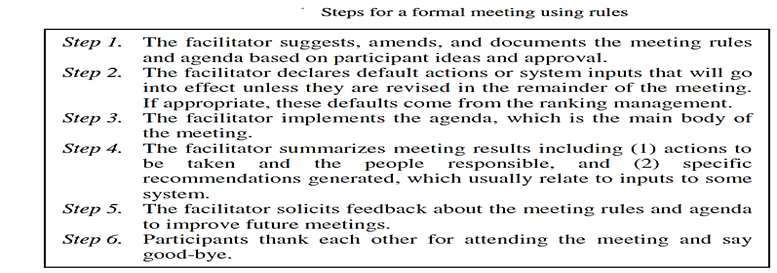Formal Meetings
Introduction:
People hold meetings in virtually all organizations and in all phases of projects. Meetings are perhaps particularly relevant in the define phase of projects, because information from many people is often needed to develop an effective charter.
Formal Meetings:
- Meetings satisfy the definition of problem-solving methods in that they can generate recommended decisions, which are inputs to systems. Also, they can involve an exchange of information. Further, there are many ways to hold meetings, each of which, in any given situation, might generate different results.
- The term “formal meeting” is used here to refer to a specific method for holding meetings. The proposed method is a hybrid of approaches in Martin et al. (1997), Robert et al. (2000) and Streibel (2002). A main purpose is to expose readers to potentially new ways of structuring meetings.
- The term “agenda” refers to a list of activities intended to be completed in a meeting.
- The term “facilitator” refers to a person with the charge of making sure that the meeting rules and agenda are followed.
- The facilitator generally acts impartially and declares any biases openly and concisely as appropriate.

The phrase “meeting wrap-up” can be used to refer simultaneously to Steps 5 and 6.
The term “brainstorming” refers to an activity in which participantspropose creative solutions to a problem. For example, the problem could be tochoose inputs and outputs for study in a project. Since creativity is desired, it can be useful to document the ideas generated in a supportive atmosphere with minimal critiquing.
The term “filtering” refers here to a process of critiquing, tuning, and rejecting ideas generate in a brainstorming process. Since filtering is a critical, negative activity, it is often separated temporarily from brainstorming.
The pair of activities, brainstorming and filtering, might appear together on an agenda inrelation to a particular topic. The phrase “has a go-round” is used here to refer to an activity in which many or all of the meeting participants are asked to comment on a particular issue. Having a go-round can be critical to learning information from shy people and making a large number of people feel “buy-in” or involvement in a decision.
Example: (Teleconferencing with Europe) An engineer in China is teleconferencing with two shy engineers in Europe who work in the same company. European engineers have greater familiarity with related production issues. The meeting objective is to finalize the KIVs, KOVs, and targets for a project charter. The Chinese engineer has e-mailed a proposed list of these previously. Use this information to suggest defaults and a meeting agenda.
Answer: Default actions: Use the e-mailed list of KIVs, KOVs, and targets.
1. Review the e-mailed list of KIVs, KOVs, and targets
2. Using a go-round, brainstorm possible KIVs, KOVs, and targets not included
3. Critique results of brainstorm using one or two go-round
4. Summarize result
5. Wrap up
Reported benefits of running formal meetings using rules include:
- Better communication, which can result in shared historical information;
- Better communication, which can result in less duplication of future efforts;
- Improved “buy-in” because everyone feels that they have been heard; and
- Increased chance of actually accomplishing meeting objectives.
These benefits often outweigh the awkwardness and effort associated with running a formal meeting.